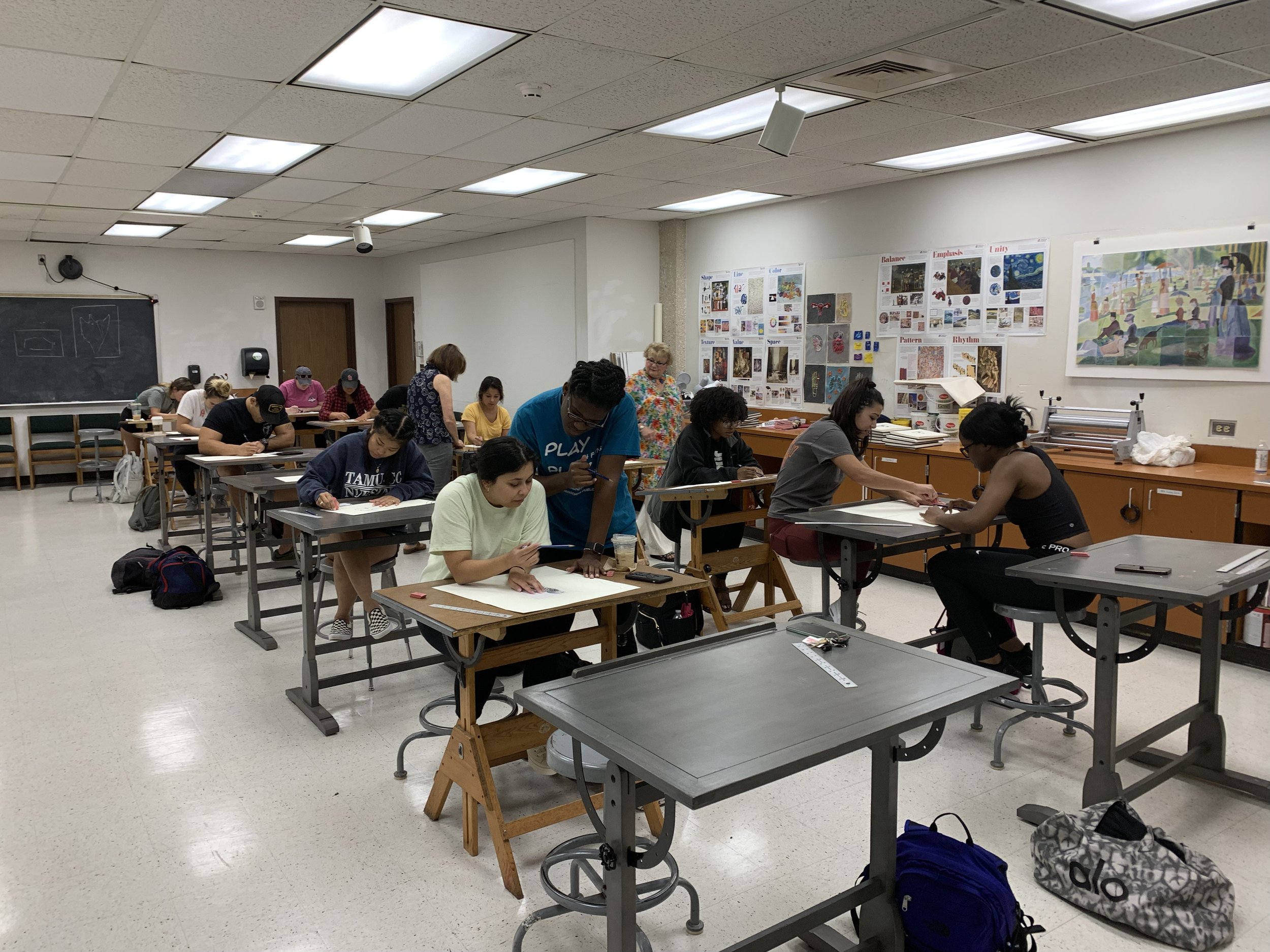Arts in Nursing
From 2020-2022 I worked with a team of faculty to develop art curriculum for the Accelerated Nursing program at TAMUCC. Each semester, students enrolled in an art class in addition to their graduate nursing courses. Our objective was to improve nursing practices by enhancing observation, communication, critical thinking, and fine motor skills. We also sought to strengthen their comfort with ambiguity and help students develop empathy through various methods. Many students remarked that art studio provided a creative outlet which promoted self-care and stress relief.
My role included advising and assisting on various assignments, and each term I was responsible for designing and teaching one project. Many emphasized the value of collaboration and teamwork. I also contributed to the Crossroads of Art and Primary Care Symposium at the Art Museum of South Texas, where I helped design, carve, and print anatomical woodblocks onto tote bags for Nursing students and faculty.
Collaborative Seurat Drawing
This project sought to help students develop greater control and sensitivity of fine motor skills while drawing. The assignment promoted teamwork and personal responsibility as each section was fundamental to the success of the entire image. Students applied knowledge of color mixing using pencils to replicate small sections of a famous George Seurat painting. They were provided a color copy of their section to observe and replicate, altering pressure and using layering to achieve various hues, values, and degrees of saturation.
Collaborative Zine
For this project students learned to simplify complex information and present it in a creative way. Students were assigned a cell, researched it to learn how it functions and created illustrations using micron pens. Part of the assignment was to gather interesting facts to explain the cell’s role in the body. Everyone’s contributions were compiled into a collaborative zine. The first semester we assigned this project, class was online, so the zine was electronic. During the second iteration, students created a 2-layer illustration and were taught how to use the Risograph to print their drawings. These were assembled in class.
Collaborative Skeletal Drawing
This activity was done during a 2-hour class period. The objective was for the students to work together to achieve a challenging task. An illustration of a skeleton was split in half vertically, and divided into several horizontal sections. Students’ desks were lined up in two rows, which correlated to how the illustration was divided. Each student drew their section of the illustration at an enlarged scale. They were asked to meet with neighbors to ensure all drawings lined up correctly, which often involved compromise. Students with more complicated sections were encouraged to ask for help, and students with simpler sections were asked to make rounds throughout the classroom to assist those who were in need. At the end of class everyone’s drawings were pieced together to create a large-scale collaborative drawing. We discussed how the intensity of working collectively to complete a shared goal mimics medical care environments.
Embroidery Assignment
This project sought to improve eye-hand coordination and fine motor skills through learning the process of embroidery. Inserting an IV, taking blood samples, placing a catheter, and applying stitches to wounds are all regular tasks which require attention to pressure and/or tension via manual dexterity. Students were provided a piece of felt with an anatomical illustration screen-printed on the surface. Over the course of two weeks, they worked on embroidering their image in a creative way. The first semester this was assigned, classes were online, so an instructional video was made to assist students working from home during the pandemic.
Linocut Prints
This project introduced students to printmaking. During the first week, students learned how to use printmaking tools to remove parts of the surface. This required creative problem-solving, as this process is reductive; what is carved away becomes negative space, and what remains uncarved prints as the positive image. Students developed patience as they learned to use the tools correctly. Throughout their careers they will need to acclimate to new methods and processes which require a willingness to learn and paying attention to multi-step instructions. During the second week, students learned how to apply ink to their blocks, register paper, and operate the printing press to create multiple prints of their image. This component reinforced following each set of instructions carefully, and through trial-and-error, they learned how to create better prints by correcting various printing issues which inevitably arose. This cultivated creative problem-solving and utilized failure as an opportunity for learning and improvement.
Drawers and Observers
This activity was done during a 2-hour class period. Students were divided into groups of 4, with two students designated as “drawers” who sat across from two “observers”. The desk tops were angled so that drawers and observers could not see each other’s images. Through verbal communication alone, observers had to describe what their image contained, and drawers had to replicate it using color pencils. The drawers were encouraged to ask thoughtful questions to help clarify the placement, scale, color, and shape of various elements and the observers were tasked with translating a complex image in a way that accurately conveyed what they were seeing. This activity challenged students as neither group was able to see how the drawing was developing or what the source image looked like until the end. In addition to effective verbal communication, students also learned how to navigate group dynamics, practice patience and cooperate to achieve a shared goal.





































